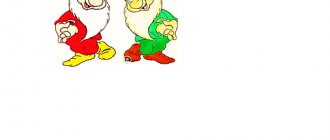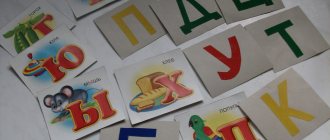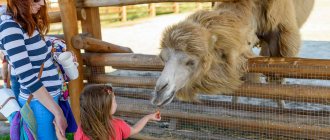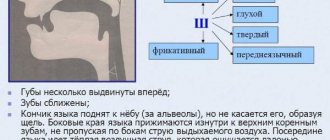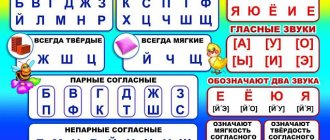LESSON SUMMARY FOR Speech Therapists
Welcome! Speech therapy site "Chatterbox" - a site for speech therapists and caring parents!Summary of a lesson on differentiating sounds [d] - [t] in syllables, words, sentences. author: Terentyeva Natalya Aleksandrovna, teacher-speech therapist MBOU secondary school No. 3 Yamalo-Nenets Autonomous Okrug, Salekhard date: 04/24/2012
target:
- clarification and comparison of articulation and sound of sounds [d] and [t];
tasks:
- teach children to differentiate sounds;
- enrich children's vocabulary;
- develop skills of syllabic analysis and synthesis;
- consolidate knowledge of language norms;
- promote the development of coherent speech, higher mental processes (development of voluntary attention, auditory memory, motor skills);
- learn to establish cause-and-effect relationships;
equipment:
- cards with articulation gymnastics;
- letters "d" and "t";
- subject pictures: melon, chair, pencil, house, plate, cabbage, bucket, slippers, bus, duck, fishing rod;
- cards with words: duck, fishing rod;
organizational moment
Whoever wants to talk must pronounce everything correctly and clearly, so that everyone can understand it. We will pronounce everything correctly and clearly, so that everyone can understand.
— In order to speak beautifully, we must do articulatory gymnastics.
articulatory gymnastics
Exercises: “Painter”, “Frog and Baby Elephant”, “Swing”. - Well done, you did a good job and your articulatory apparatus is ready for further work.
development of phonemic awareness
- Look at the object pictures and name them. (Duck, fishing rod). - How many sounds are in these words? (6 sounds). - These are very similar words to “duck-fishing rod”. - How do they differ? — In the word “fishing rod” the second sound is [d]. — In the word “duck” the second sound is [t].
The words “duck” and “fishing rod” are posted on the board.
- Look, they changed one letter, but the whole word has changed. - Today we will learn to distinguish between the sounds [d] and [t] and the letters “d” and “t”, so as not to confuse them in writing.
comparative characteristics of sounds
- Let's characterize our sounds.
- Say the sounds [d] and [t]. Is the position of the lips the same when pronouncing these sounds? (Equal).
- How do we pronounce these sounds? The lips are slightly parted, the tip of the tongue rests on the upper teeth, and the exhaled air “explodes” this barrier. Consonant sounds.
— Put your hand on the neck and listen, does the neck tremble when pronouncing the sound [d]? (Trembles). - Is this sound pronounced with or without a voice? (With voice).
- Now pronounce the sound [t] and listen, does your throat tremble when pronouncing this sound? (Doesn't shake). This means that the sound is pronounced without a voice.
- We can draw a conclusion. The sound [d] is pronounced with a voice, it is sonorous and is determined by the letter “d” in writing and when reading. And the sound [t] is pronounced without a voice, it is deaf and is determined by the letter “t” in writing and when reading.
[t] - consonant, deaf, pronounced without voice. [d] - consonant, voiced, voice is involved in pronunciation.
correlation of sound and letter
— Sounds in writing and when reading are indicated by what? (In letters). - Remember what letter elements we need to write lowercase letters and make up these letters. - Tell me, if you put a consonant and a vowel sound together, what do they form? (Syllable).
differentiation of sounds in syllables
- Look at the diagram, compose and read the syllables. - Write down the syllables in pairs according to voiced-voicelessness. (Write on the board). - Indicate in them the presence of sounds studied in class.
T\A O U/D
- TA, TO, TU; - YES, DO, DU;
- What is formed from syllables? (Words). - Open your notebooks, move 2 lines down and write down today’s date.
differentiation of sounds in words
— Now let’s play the game “What is where?” — We will write down the guessed word in a notebook and highlight the letters with which we are working today. Pictures: melon, chair, pencil, house, plate, cabbage, bucket, slippers, bus.
— What sound do we hear in the word “cabbage”? (In the word “cabbage” we hear the sound [t]. It is consonant, unvoiced. So, we draw a bell without a tongue. We write the letter “t”).
- What sound do we hear in the word “house”. (In the word “house” we hear the sound [d]. It is consonant, sonorous. So, we draw a bell with a tongue. We write the letter “d”).
The rest of the words are analyzed by analogy.
“The guys did a good job with this task.” — Tell me, what do words that are related to each other in meaning form? (Offers).
differentiation of sounds in a sentence
- Make sentences from these words and think about what kind of story can come out of these sentences.
U, house, in the village, grandfather. Pond, villages, approx. In the summer, Tyoma, was with his grandfather.
- Read what you got.
- Write down each of your sentences in a notebook and find our letters in it.
- Highlight our letters, as we did in words.
— Sentences related to each other in meaning form what? (Story).
- Let's try to put our sentences so that we get a story. (Grandfather has a house in the village. There is a pond near the village. In the summer, Tyoma was with grandfather.)
- Come up with a continuation of our story. (I option: He went fishing in the summer. There were a lot of fish in the pond. Tyoma likes to relax in the village in the summer. II option: Grandfather gave Tyoma a fishing rod. The boy went fishing every morning. He gave the fish to the cat Vaska. The boy loves fishing very much.)
- How can we title our text?
lesson summary
- What sounds did we learn to distinguish in our lesson? ([t], [d]). - Give a brief description of these sounds.
[t] - consonant, deaf, pronounced without voice. [d] - consonant, voiced, voice is involved in pronunciation.
- Why did we learn to distinguish these sounds? (To write without errors).
Summary of a speech therapy lesson in the senior group “Visiting a fairy tale. Differentiation of sounds d - t"
Summary of a speech therapy lesson in the senior group “Visiting a fairy tale. Differentiation of sounds d - t"
Author: Tsivileva Oksana Yuryevna Teacher – speech therapist of the first qualification category
Municipal budgetary
preschool educational institution
combined type kindergarten No. 14 “Fairy Tale”, Verkhniy Ufaley city, Chelyabinsk region
Goal: teach children
distinguish sounds d-in isolation, in syllables, words.
Objectives: Correctional - educational: Teach children
to give acoustic and articulatory characteristics of d-t sounds based on various types of control.
Strengthen children’s ability to compose complete sentences with the preposition “for.” Correctional and developmental: Develop articulatory and fine motor skills
through the use of gaming technologies. Develop phonemic processes: the ability to hear sounds, isolate them in the flow of speech, the ability to determine the presence and place of sounds in a word. Development of memory, attention, perception and other mental processes. Correctional and educational: To develop responsiveness, the ability to work in a team and individually, the ability to listen to the teacher and other children.
Equipment: presentation, beads, cord, object pictures with sounds, etc., logo disks, clothespins, forms with cereals.
Organizing time.
Speech therapist: Hello, guys. Guests have come to you today, look at them, smile at them. And now all attention is on me. Let's gather children in a circle. I am your friend and you are my friend. Let's hold hands tightly and smile at each other.
Let's get acquainted, I'm Oksana Yuryevna, and what's your name? Say your name affectionately. Let’s sit down quietly, and I’ll tell you why I came to you. But I had a problem. I went to the kids to read them a fairy tale, but on the way I discovered that the characters had changed places, which means I wouldn’t be able to tell it. And they told me that you are smart and good guys and already know a lot. This is true? Children: Yes.
Speech therapist: Then I’m sure you can help me. Guess what fairy tale I wanted to read to the kids? Grandmother, grandfather, and with them a granddaughter, a Mouse, a cat, and also a Bug. Together everyone was able to pull her out of the ground. Children: "Turnip." Speech therapist: Will you help me return the heroes of the fairy tale “Turnip” to their places? Children: Let's help.
Report the topic of the lesson.
Speech therapist: In order to quickly return to their place and pull out the turnip, our heroes must be hardworking and friendly. - What sound does the word friendly begin with? Children: from the sound d. Speech therapist: What sound does the word hardworking begin with? Children: with the sound T. Speech therapist: By playing with the sounds T-D we will help the heroes of the fairy tale return to their places.
Articulation gymnastics.
Speech therapist: Let's go and sit on the chairs, straighten our backs, put our feet on the floor. Heroes really love it when guys speak beautifully, let's agree with you to answer in complete sentences and pronounce all sounds correctly. And gymnastics for our tongue will help us with this. Repeat the exercises you hear in the poem. So the fairy tale has begun. Let’s smile at her now. (“Smile”) There is a fence ahead. It looks very strong. (“Fence”) Here’s a spatula. We’ll dig up the beds right away. (Spatula) Tap and tap with a hammer, only a quiet sound is heard. ("Hammer")
Work on the topic of the lesson:
Speech therapist: Guys, remember who the first hero is in the fairy tale “Turnip”. Look at the screen, who will we help? Children: Let's help grandpa. — Acoustic and articulatory characteristics of sounds: Speech therapist: For grandfather to return to his place, you need to tell everything you know about sounds, etc. Let's pronounce the sound T together. What does it look like?
Children (pronounce the sound t): It sounds like the sound of a hammer. Speech therapist: Say it again. Where is the tongue? Children: He knocks on his upper teeth. Speech therapist: Let’s say the sound D together. What does this sound sound like? Children: It looks like a woodpecker knocking with its beak.
Speech therapist: Pay attention to the screen, grandfather walked a little and stopped, we probably didn’t tell everything about these sounds. Tell me, what sounds are there? Children: Sounds are vowels and consonants. Speech therapist: Give a description of the sound T according to this scheme. Children: sound t - consonant, deaf, hard. Speech therapist: now let’s characterize the sound D. Children: the sound D is consonant, voiced, hard.
Speech therapist: These sounds are consonant and hard - and this is how they are similar, but how do they differ from each other? Children: the sound d is voiced, and the sound t is unvoiced. Speech therapist: Let's see what next test we have to pass. Let's help grandpa pronounce a track of sounds. when we see a hammer, we pronounce the sound t and quietly hit our fists; when we see a woodpecker, we pronounce the sound d and hit our knees with our palms. Attention to the screen. Now let's repeat the track faster.
— Development of phonemic hearing:
Speech therapist: Grandfather also loves the game “Catch the Sound.” Do you want to play it? Clap your hands once when you hear the sound d, stamp once when you hear the sound t. A-u-d-i-t-p-n-t-t-d-v-d. Well done, you were very attentive. Let's look at the screen, did we help grandfather get into his place? What did grandpa do? Children: Grandfather took up the turnip. Great, let's continue. Speech therapist: Who will we help next? Children: Let's help grandma.
Speech therapist: Grandma loves to write poetry, and she invites you to complete your pure words with one word that contains our sounds. Doo-doo-doo - I'm going to my grandfather Doo-doo-doo - there's a lot of water here Ost-ost-ost - I'll build a bridge.
Children: (Choral and individual pronunciation of pure phrases) Speech therapist: Grandma will fall into place if we help her build a bridge. Stand in your places, I will name a syllable, and you will replace the sound t in it with the sound d. Say the syllables together, marching in place. Ta-da To-do Tu-du You-dy Te-de. Speech therapist: Excellent, and you coped with these tests. And grandma is very glad that she has returned to her place. Who is grandma behind? Children: Grandmother stands behind grandfather. Speech therapist: Name the next hero we will help. Children: The next hero is a granddaughter.
Speech therapist: My granddaughter loves to dress up, but she scattered her favorite beads. Can we help you collect them? You will see a picture on the screen. Name it, determine what sound it is and where it is, and put the bead on the cord. Listen to how to say: This is a tub. This word has the sound D, it is in the middle of the word. Children: Take turns answering based on the presentation. And they put on beads. Speech therapist: Okay, and the granddaughter took her place. Who is she behind? Children: The granddaughter is standing behind the grandmother.
Speech therapist: And the next hero is the dog Zhuchka, she loves to frolic and you and I will have a rest. Repeat the movements after me. “Physical pause” Instead of trampling the beds to no avail, get ready to exercise. Dawn is breaking. Grandfather came out onto the porch. He sees a turnip in the garden. And he doesn’t seem to believe himself. He stood next to the turnip, The turnip was higher than the cap. The bug jumps, frolics, She can’t sit idle. She needs to take her place to help her grandfather.
Speech therapist: you had a great rest, look at the screen, and answer in a complete sentence who the Bug is behind. Children: The bug is standing behind the granddaughter. Speech therapist: Who will remember the next hero of the fairy tale? Children: The next hero of the fairy tale is a cat.
Speech therapist: Now we will divide into two teams, the girls will go to the first table, and the boys to the second. Look, there are pictures in front of you whose names contain our sounds d, t. Each of you will take one picture and attach it to a circle using a clothespin. But be careful, girls choose pictures whose names have the sound d, and boys choose pictures whose names have the sound t. Get started, and then we will check whether you coped with this test correctly.
Children: Each child names the picture that he has attached and compares it with the picture on the screen. Speech therapist: You are doing great, and so we helped the cat. Who will she stand behind? Children: The cat will stand behind the dog Bug. Speech therapist: Guys, who are the heroes left who haven’t been helped yet? Children: We didn't help the mouse. Speech therapist: If you want to know the name of the mouse, collect its name from the sounds that I will tell you: t...o...m...a. Children: Tom.
Speech therapist: Come with me to the table and listen to how we can help her, because she is lost and cannot find her way. The woman is at home, the grandfather is at home. Only Tom is not at home. Where is our Tom? She is standing near the house.
Which of these houses do you think belongs to our Tom? What is the first sound in her name? Children: A house with a hammer on it. Speech therapist: Draw a path from the mouse to its house with your finger. Now let’s walk along this path with two fingers, pronouncing our d-t sounds. So the mouse was in its place. Who did she stand behind? Children: She stood behind the cat.
Bottom line
Speech therapist: Let's look at the screen, have all the heroes returned to their places? And what sounds helped us? Children: the sounds d, t helped us.
Assessing children's work in class. Remember guys, at the end of the fairy tale the heroes pulled out a turnip, and I brought it to you, but let’s see the turnip is unusual, but with a surprise. The heroes say thank you for helping them return to their place and so that you don’t forget about our meeting, they give you coloring books. And I want to thank you, because now I can go to the kids and read them a fairy tale!

